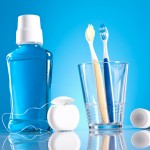
Toothbrushing and interdental cleaning are common way of removing and disrupting the microbial biofilms (dental plaque) that build up on teeth. However, many find it difficult to achieve effective plaque control. Chlorhexidine (CHX) mouthwashes are widely marketed and used for chemical plaque control and are available in a variety of concentrations (≤ 0.06%, 0.1%, 0.12% or 0.2%).
The aim of this Cochrane review was to assess the effectiveness of chlorhexidine mouthrinse used as an adjunct to mechanical oral hygiene procedures for the control of gingivitis and plaque compared to mechanical oral hygiene procedures alone or mechanical oral hygiene procedures plus placebo/control mouthrinse.
Methods
The Cochrane Oral Health’s Trials Register; Cochrane Central Register of Controlled Trials (CENTRAL) Medline; ClinicalTrials.gov and the World Health Organization International Clinical Trials Registry Platform databases were searched with no restrictions.
Randomised controlled trials (RCTs) assessing the effects of CHX mouthrinse used as an adjunct to mechanical oral hygiene procedures for at least 4 weeks on gingivitis in children and adults were considered. Standard Cochrane data collection and analysis methods were followed.
Results
- 51 RCTS involving a total of 5345 patients were included
- 50 studies were at high risk of bias, 1 at low risk
- 16 studies had two study arms, 35 had multiple study arms
- 6 studies involved children and adolescents
- Gingivitis
- In patients with mild gingivitis (Gingival Index [GI] 0 to 3 scale) after 4-6 weeks use CHX mouthrinse reduced gingivitis by 0.21 (95% CI; 0.11 to 0.31) compared to placebo, control or no mouthrinse with a similar effect being seen at 6 months. [High quality evidence]
- For patients with moderate or severe gingival inflammation (GI scores of 1.1 to 3) there were insufficient data to determine the reduction in gingivitis associated with chlorhexidine mouthrinse
- Plaque
- At 4-6 weeks there was a large effect in favour of CHX mouthrinse, SMD (standardised mean difference) = -1.45 (95%CI; -1.90 to -1.00) [12 trials, 950 participants analysed, high-quality evidence].
- A similar large reduction was found for chlorhexidine mouthrinse use at 6 months.
- Calculus
- Results for the effect of chlorhexidine mouthrinse on calculus formation were inconclusive.
- Effect of concentration and frequency of rinsing
- There were insufficient data to determine whether there was a difference in effect for either chlorhexidine concentration or frequency of rinsing.
- Extrinsic tooth staining
- There was a large increase in extrinsic tooth staining in participants using chlorhexidine mouthrinse at 4 to 6 weeks. SMD = 1.07 (95%CI; 0.80 to 1.34). There was also seen at 7 to 12 weeks and 6 months.
- Other adverse effects
- 11 studies reported taste disturbance/alteration
- 13 studies noted effects on the oral mucosa including soreness, irritation, mild desquamation and mucosal ulceration/erosions
- 9 studies reported general burning sensation or a burning tongue or both
Conclusions
The authors concluded:-
There is high-quality evidence from studies that reported the Löe and Silness Gingival Index of a reduction in gingivitis in individuals with mild gingival inflammation on average (mean score of 1 on the 0 to 3 GI scale) that was not considered to be clinically relevant.
There is high-quality evidence of a large reduction in dental plaque with chlorhexidine mouthrinse used as an adjunct to mechanical oral hygiene procedures for 4 to 6 weeks and 6 months.
There is no evidence that one concentration of chlorhexidine rinse is more effective than another.
There is insufficient evidence to determine the reduction in gingivitis associated with chlorhexidine mouthrinse use in individuals with mean GI scores of 1.1 to 3 indicating moderate or severe levels of gingival inflammation.
Rinsing with chlorhexidine mouthrinse for 4 weeks or longer causes extrinsic tooth staining. In addition, other adverse effects such as calculus build up, transient taste disturbance and effects on the oral mucosa were reported in the included studies.
Comments
This Cochrane review included 51 studies only 1 of being considered to be at low risk of bias. The man reason for this was due to problems with blinding of the patients, study personnel and outcomes assessors largely due to the tendency for CHX to stain teeth.
Over half of the studies were in some way affiliated or supported with industry with only one of the 19 directly funded studies indicating that the conduct of the research and final decisions regarding the study report were independent of the company providing the support.
Even with these caveats the authors considered that there is high-quality evidence that CHX mouthwash used as an adjunct to mechanical oral hygiene procedures resulted in a large reduction in plaque in the short-term. A reduction in gingivitis in patients with mild gingivitis was also supported by high quality evidence but not considered to be clinically relevant. The review also confirms the well-known tendency for tooth staining with CHX mouthwash use and notes a range of other adverse events.
Links
Primary paper
James P, Worthington HV, Parnell C, Harding M, Lamont T, Cheung A, Whelton H, Riley P. Chlorhexidine mouthrinse as an adjunctive treatment for gingival health. Cochrane Database of Systematic Reviews 2017, Issue 3. Art. No.: CD008676. DOI: 10.1002/14651858.CD008676.pub2.
Other references
Dental Elf – 18th Oct 2016

[…] Chlorhexidine mouthrinse: Reduced plaque and gingivitis when used as adjunct to mechanical oral hygi… […]